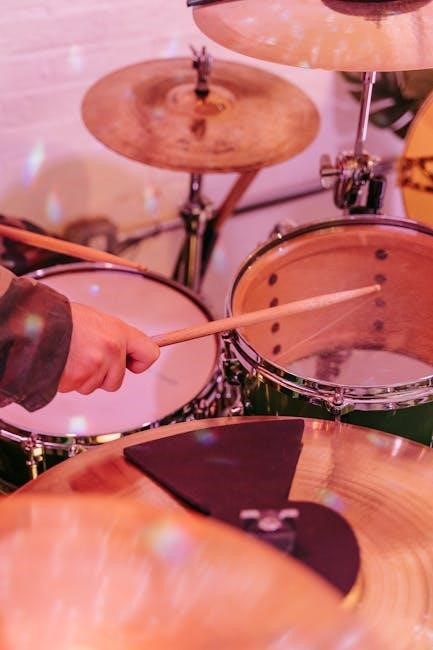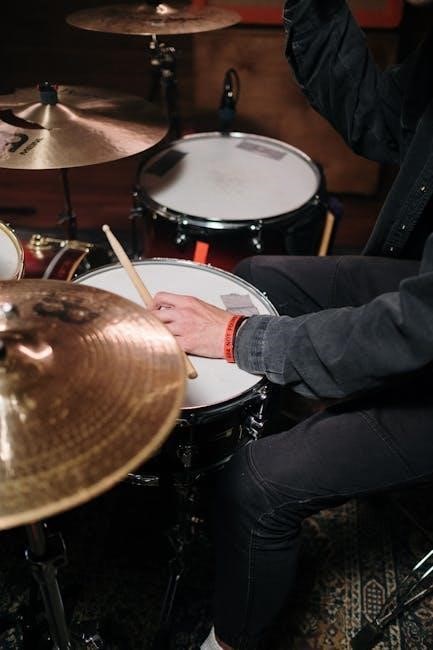
Stick control is essential for developing proper snare drum technique, coordination, and musical expression. The “Stick Control for the Snare Drummer” PDF by George Lawrence Stone provides foundational exercises to improve hand speed, accuracy, and rhythmic precision, making it a cornerstone for drummers of all levels.
Understanding the Importance of Stick Control
Stick control is the foundation of snare drum technique, enabling precise rhythmic execution and musical expression. It enhances coordination, speed, and accuracy, allowing drummers to perform complex patterns effortlessly. Proper stick control also fosters consistency and endurance, essential for demanding performances.
By mastering stick control, drummers gain the ability to play with dynamics, articulation, and finesse, elevating their overall musicianship. It is a skill that transcends technical proficiency, connecting the drummer to the music itself, making it indispensable for all levels of drumming.
Overview of the “Stick Control for the Snare Drummer” PDF
The “Stick Control for the Snare Drummer” PDF, authored by George Lawrence Stone, is a comprehensive guide designed to improve snare drum technique. It focuses on exercises that develop hand coordination, speed, and rhythmic accuracy, making it a valuable resource for drummers of all skill levels. The PDF emphasizes foundational skills, providing a structured approach to mastering stick control, which is essential for both technical proficiency and musical expression in various drumming contexts.

Basic Techniques in Stick Control
Mastering stick control begins with proper grip, stroke types, and wrist movement. These fundamentals ensure precision and consistency, forming the foundation for advanced techniques in snare drumming.
Proper Grip and Stance

A proper grip and stance are fundamental to effective stick control. The matched grip is most common, with sticks balanced between thumb and index finger. Traditional grip, with palms facing downward, suits orchestral settings. Stand tall with feet shoulder-width apart, snare drum at waist height. Relaxed posture ensures freedom of movement. Grip firmly but not overly tight, allowing wrists and fingers to move freely. Proper alignment prevents fatigue and enhances precision. Consistent stance and grip provide the foundation for accurate and controlled strokes, essential for mastering stick control exercises and techniques.
Wrist and Finger Independence
Wrist and finger independence is crucial for precise stick control. Exercises like finger spreads and chromatic exercises enhance dexterity. Start with fingers moving independently, then incorporate wrist motion. Practice rudiments slowly, focusing on even strokes. Avoid tension to maintain fluidity. Strengthening finger independence allows for complex patterns and clean execution of strokes like paradiddles. Consistent practice builds coordination, enabling smooth transitions between techniques. Developing independence ensures accurate articulation and control, essential for mastering advanced stick control exercises and applying them in musical contexts.
Basic Stroke Types: Downstrokes, Upstrokes, and Taps
Mastering basic stroke types is fundamental for stick control. Downstrokes are executed with a downward motion, emphasizing wrist and forearm movement. Upstrokes involve lifting the stick with finger and wrist action. Taps are light, controlled strikes on the drumhead. Practicing these strokes at slow tempos ensures accuracy and control. As speed increases, focus on maintaining evenness and precision. These foundational strokes build the technical skills needed for advanced rudiments and musical expression, providing a solid base for further development in stick control and rhythmic accuracy.

Developing Coordination and Timing
Coordination and timing are refined through targeted exercises, emphasizing limb independence and rhythmic accuracy. Paradiddles and timing drills, often practiced with a metronome, enhance overall control and precision.
Exercises for Building Hand Coordination
Building hand coordination is critical for effective stick control. Exercises like single strokes, double strokes, and paradiddles help develop limb independence and rhythmic clarity. Starting with slow tempos and gradually increasing speed ensures proper technique. Incorporating a metronome enhances timing accuracy, while focusing on evenness and consistency between hands strengthens overall control. These exercises, outlined in the “Stick Control for the Snare Drummer” PDF, form the foundation for advanced techniques and musical expression, making them indispensable for drummers at every skill level.
Timing exercises are fundamental for developing a strong rhythmic foundation. The “Stick Control for the Snare Drummer” PDF emphasizes exercises that improve accuracy and consistency. Practicing with a metronome helps internalize rhythms, ensuring precise execution of notes and rests. Subdivision exercises, such as playing on beats and offbeats, enhance timing awareness. These drills prepare drummers for complex musical scenarios, fostering a reliable internal clock and improving overall performance. Regular practice of timing exercises is essential for mastery of stick control techniques.
Practicing with a Metronome
Practicing with a metronome is crucial for developing precise timing and consistency. Start by setting the metronome to a slow tempo and focus on playing exercises accurately. Gradually increase the speed as you build comfort. This tool helps internalize rhythmic patterns and improves coordination. Begin with basic subdivisions like quarter notes, then progress to eighth and sixteenth notes. Regular metronome practice ensures a strong internal clock, essential for mastering stick control techniques. It also enhances overall timing accuracy, making it indispensable for snare drummers aiming to refine their skills.

Advanced Stick Control Techniques
Advanced techniques involve complex stroke combinations, dynamic control, and intricate rhythmic patterns. Paradiddles and syncopation exercises enhance precision and musicality, pushing drummers to master advanced rhythmic execution seamlessly.
Dynamic Control: Playing with Different Volumes
DYNAMIC CONTROL IS VITAL FOR EXPRESSIVE DRUMMING. IT INVOLVES PLAYING WITH VARYING VOLUMES, FROM SOFTEST PIANO TO LOUDEST FORTISSIMO. STICK CONTROL EXERCISES FOCUS ON GRADUAL TRANSITIONS, ENSURING SMOOTH SHIFTS IN DYNAMICS. PLAYERS LEARN TO ADAPT STROKE FORCE AND Wrist Motion TO ACHIEVE DESIRED VOLUME LEVELS. THIS SKILL ENHANCES MUSICALITY, ALLOWING DRUMMERS TO CONVEY EMOTION AND NUANCE IN THEIR PERFORMANCE. PRACTICING WITH A METRONOME HELPS DEVELOP CONSISTENCY ACROSS DYNAMIC RANGES, ESSENTIAL FOR BOTH SOLO AND ENSEMBLE SETTINGS.
Advanced Stroke Combinations
ADVANCED STROKE COMBINATIONS INVOLVE INTEGRATING VARIOUS RUDIMENTS INTO COMPLEX PATTERNS. DRUMMERS EXPLORE COMBINING SINGLE AND DOUBLE STROKES WITH PARADIDDLES, FLAMS, AND DRAGS TO CREATE INTRICATE RHYTHMS. THESE EXERCISES DEMAND PRECISE TIMING AND CONTROL, AS WELL AS THE ABILITY TO TRANSITION SMOOTHLY BETWEEN STROKES. BY MASTERING THESE COMBINATIONS, DRUMMERS CAN DEVELOP A HIGH LEVEL OF TECHNICAL PROFICIENCY AND EXPRESSIVENESS. PRACTICING WITH A METRONOME HELPS ENSURE ACCURACY, WHILE FOCUSING ON DYNAMICS ADDS DEPTH TO THE PERFORMANCE. THIS SKILL IS ESSENTIAL FOR BOTH SOLOING AND PLAYING IN ENSEMBLES.
Syncopation and Accent Studies
Syncopation and accent studies are crucial for developing rhythmic sophistication and dynamic control. These exercises focus on playing off-beat rhythms and emphasizing specific notes within a pattern. By practicing syncopation, drummers improve their ability to play complex time feel and add musicality to their performances. Accent studies enhance tonal contrast, allowing for dramatic shifts in volume and expression. These techniques are particularly useful in jazz and orchestral settings, where precise rhythmic execution and dynamic nuance are essential. Regular practice of these exercises strengthens overall stick control and musicianship, preparing drummers for advanced repertoire and ensemble playing.

Rudiments and Their Application
Rudiments form the foundation of drumming technique, including single strokes, double strokes, and paradiddles. These exercises build technical skill and musicality, essential for precise execution and expression.
Single Strokes and Double Strokes
Single strokes involve striking the drum with one stick, focusing on precision and control. Double strokes require quick wrist and finger movements, producing two notes in rapid succession. Both are fundamental for building speed, accuracy, and endurance. Regular practice of these strokes enhances coordination and strengthens basic drumming technique, as outlined in the “Stick Control for the Snare Drummer” PDF. Mastery of single and double strokes is essential for executing more complex rudiments and maintaining consistency in performance.
Paradiddles and Their Variations
Paradiddles are essential rudiments that combine single and double strokes, enhancing hand speed, coordination, and rhythmic accuracy. They involve a double stroke followed by a single stroke, creating a smooth, flowing sound. Variations include reversing the sticking pattern or incorporating different limbs. Practicing paradiddles improves sticking consistency and limb independence, making them versatile for various musical styles. The “Stick Control for the Snare Drummer” PDF offers exercises that progress from basic paradiddles to more complex variations, helping drummers develop precision and adaptability in their technique.
Flams and Drag Rhythms
Flams and drag rhythms are advanced rudiments that add musicality and texture to drumming. A flam involves striking the drum with both sticks simultaneously, creating a full, resonant sound. Drag rhythms incorporate grace notes, often played with one stick dragging across the drumhead, adding rhythmic complexity. These techniques require precise timing and control, which are thoroughly addressed in the “Stick Control for the Snare Drummer” PDF. By mastering flams and drags, drummers can enhance their rhythmic precision and apply these techniques in various musical contexts, from orchestral settings to modern drumming styles.
Practical Application in Musical Contexts
Stick control techniques are versatile, enhancing rhythmic precision in orchestral, jazz, and rudimental drumming. They provide a foundation for intricate musical expression across diverse genres, ensuring adaptability and artistry.
Applying Stick Control in Orchestral Settings
Stick control is crucial in orchestral settings, where precision and dynamic subtlety are paramount. Drummers must master legato and staccato strokes to blend seamlessly with the ensemble. Stick Control for the Snare Drummer provides exercises that enhance rhythmic accuracy and tonal control, essential for orchestral repertoire. Techniques like controlled rebounds and nuanced articulations ensure clarity in intricate passages. By refining these skills, drummers can deliver performances that align with the ensemble’s balance and phrasing, contributing to a polished and cohesive orchestral sound.

Stick Control in Jazz and Modern Drumming
Stick control is vital in jazz and modern drumming, where intricate rhythms and improvisation demand precision. The exercises in Stick Control for the Snare Drummer enhance coordination, allowing drummers to execute complex time signatures and polyrhythms effortlessly. Jazz drumming often requires dynamic contrast and subtle phrasing, which are refined through controlled strokes and finger independence. Modern drumming extends these principles to genres like rock and pop, emphasizing groove and versatility. By mastering stick control, drummers can achieve the technical prowess and musicality needed for diverse contemporary styles, making it a cornerstone of modern drumming technique.
Using Stick Control in Rudimental Drumming
Rudimental drumming relies heavily on stick control to execute complex patterns like single strokes, double strokes, and paradiddles. The exercises in Stick Control for the Snare Drummer are designed to build the precision and dexterity needed for these foundational rudiments. By mastering stick control, drummers can perform rolls, flams, and drags with clarity and consistency. This skill is particularly vital in orchestral and marching band settings, where intricate rhythms must be played in unison. Effective stick control enhances overall technical proficiency, allowing rudimental drumming to be both powerful and precise.
Choosing the Right Equipment
Selecting the right drumsticks and adjusting drumhead tension are crucial for optimal performance. Drumstick weight and tip material impact tone and control, while proper drumhead tension enhances sound quality and technique.
Selecting the Appropriate Drumsticks
Selecting the right drumsticks is crucial for effective stick control. The weight, material, and tip shape significantly impact sound quality and technique. Lighter sticks provide agility, while heavier sticks offer power. Wooden sticks are traditional, but synthetic options durability. The tip shape, whether round, teardrop, or barrel, affects articulation. For snare drumming, a balanced stick with a medium weight and rounded tip is ideal. The “Stick Control for the Snare Drummer” PDF emphasizes matching sticks to playing style and musical context for optimal performance and control.
Understanding Drumhead Tension and Its Impact
Drumhead tension significantly influences sound quality and playability. Proper tension ensures clear tones and consistent rebound, crucial for stick control. Over-tightened heads produce rigid, brittle sounds, while under-tightened heads yield muddy tones. The “Stick Control for the Snare Drummer” PDF highlights the importance of balanced tension for precise articulation and dynamic range. Environmental factors like humidity can affect tension, necessitating regular adjustments. Understanding and maintaining optimal drumhead tension is vital for achieving the desired musical expression and technical accuracy in snare drumming.
Effective Practice Routines
Consistent practice with “Stick Control for the Snare Drummer” PDF is key. Start with slow tempos, focus on accuracy, and gradually increase speed. Paradiddles and daily schedules help build endurance and precision, ensuring steady progress in stick control techniques.
Setting Up a Daily Practice Schedule
A well-structured daily practice schedule is crucial for mastering stick control. Begin with 10-15 minutes of warm-ups, focusing on basic strokes like single strokes and paradiddles. Dedicate 20-30 minutes to exercises from the “Stick Control for the Snare Drummer” PDF, starting with slower tempos and increasing gradually. Incorporate metronome work to improve timing accuracy. Allocate 10-15 minutes for advanced techniques like flams or drag rhythms. Conclude with 5-10 minutes of cool-down exercises to relax the hands. Consistency and patience are key to building endurance and precision in stick control.
Warm-Up Exercises for Stick Control
Begin with basic strokes like single strokes and downstrokes to loosen the wrists and fingers. Incorporate slow, controlled movements to build precision. Use rudiments such as paradiddles and flams to enhance coordination. Start with a slow tempo and gradually increase speed. Practice long rolls to improve endurance and evenness. Include dynamic control exercises, playing from soft to loud. Finish with limb independence exercises, focusing on isolating hands and feet. These warm-ups prepare the hands for more complex techniques and ensure a smooth transition into the exercises outlined in the “Stick Control for the Snare Drummer” PDF.
Tracking Progress and Adjusting Practice
Regularly track progress by recording practice sessions and comparing them over time. Use a metronome to measure improvements in timing accuracy. Set specific goals for speed, control, and dynamics. Adjust practice routines based on weaknesses identified during exercises. Focus on quality over quantity, ensuring each stroke is precise. Gradually increase tempo as control improves. Celebrate small victories to stay motivated. Maintain consistency by dedicating time daily to stick control exercises. This structured approach ensures steady development and mastery of techniques outlined in the “Stick Control for the Snare Drummer” PDF.

Common Challenges and Solutions
Drummers often face fatigue, technical difficulties, and maintaining motivation. Solutions include proper warm-ups, consistent practice, and setting realistic goals to overcome these challenges effectively.
Overcoming Fatigue and Maintaining Endurance
Fatigue is a common challenge for snare drummers. To maintain endurance, start with short practice sessions and gradually increase duration. Incorporate warm-ups focusing on finger independence and wrist relaxation. Use proper grip and stance to avoid strain. Take regular breaks to stretch and recharge. Prioritize consistent technique to reduce physical effort. Stay hydrated and maintain a balanced diet for energy. Incorporate mental strategies like deep breathing to stay focused and relaxed during practice. Over time, these habits will build stamina and reduce fatigue, allowing for more efficient and enjoyable practice sessions.

Addressing Technical Difficulties
Technical difficulties in stick control often arise from poor grip, lack of wrist independence, or inconsistent strokes. Start by identifying specific issues, such as uneven taps or struggles with paradiddles; Practice problematic exercises at a slow tempo, focusing on precision and control. Use a metronome to ensure accuracy and gradually increase speed. Incorporate targeted warm-ups, like finger stretches and rudimental exercises, to build dexterity. Break complex patterns into smaller sections and rebuild them systematically. Patience and consistent practice are key to mastering technical challenges and achieving smooth, professional execution of stick control exercises.
Mental Focus and Concentration Techniques
Mental focus is crucial for mastering stick control. Start by practicing mindfulness to clear distractions. Break exercises into smaller sections and focus on one element at a time. Use visualization techniques to imagine perfect execution before playing. Incorporate breathing exercises to stay calm and centered. Set specific goals for each practice session to maintain direction. Record yourself to identify areas needing improvement. Regular mental practice, even without instruments, can enhance muscle memory and coordination. Consistent focus on these techniques will lead to greater precision and confidence in your playing.

Resources for Further Learning
Explore the “Stick Control for the Snare Drummer” PDF by George Lawrence Stone for foundational techniques. Supplement with books like Kevin Tuck’s Drum Book and online tutorials for advanced drills.
Recommended Books and PDF Guides
For mastering stick control, the “Stick Control for the Snare Drummer” PDF by George Lawrence Stone is indispensable. It provides comprehensive exercises for improving technique, speed, and precision. Additional resources like Kevin Tuck’s Drum Book and other PDF guides offer advanced drills and rhythmic studies. These materials are widely available online, with many accessible via platforms like Google Books or Scribd. They cater to drummers of all skill levels, ensuring a well-rounded approach to stick control and overall drumming proficiency.
Online Tutorials and Video Lessons
Online tutorials and video lessons offer a dynamic way to master stick control. Platforms like YouTube and Drumeo provide extensive libraries of instructional content, featuring lessons from renowned drummers. These videos often include demonstrations of exercises from the “Stick Control for the Snare Drummer” PDF, breaking down techniques for better understanding. Additionally, websites like ArtistWorks and TrueFire offer structured courses tailored to improving stick control and rhythmic accuracy. These resources are ideal for visual learners and those seeking guidance from professional instructors, making practice more engaging and effective.
Joining Drumming Communities for Support
Joining drumming communities enhances your learning journey by connecting you with fellow musicians and instructors. Online forums, social media groups, and local drumming meetups provide platforms for sharing tips, asking questions, and gaining insights. These communities often discuss resources like the “Stick Control for the Snare Drummer” PDF, offering practical advice and motivation. Engaging with others who are mastering stick control fosters accountability and accelerates progress. Collaborative learning and mutual encouragement make the process enjoyable and rewarding, helping you stay committed to improving your technique and achieving your drumming goals.
Mastering stick control enhances technical precision, musicality, and versatility, empowering drummers to excel in various genres and maintain a lifelong commitment to artistic growth and excellence.
Summarizing Key Points
The “Stick Control for the Snare Drummer” PDF by George Lawrence Stone is a comprehensive guide to mastering snare drum technique. It emphasizes foundational exercises to improve hand speed, coordination, and rhythmic accuracy. The book covers essential strokes, timing, and dynamic control, providing a structured approach for drummers of all skill levels. By focusing on consistency and precision, it helps build the technical proficiency needed for various musical contexts, from classical to modern drumming. Regular practice with this guide ensures steady progress and enhances overall drumming versatility and expression.
Motivation for Continuous Improvement
Motivation is crucial for mastering stick control, as consistent practice and dedication are essential for progress. Drummers who embrace the challenges of stick control often find a deep sense of accomplishment and musical growth. By setting achievable goals and celebrating small victories, players stay inspired to refine their technique; The ability to execute complex rhythms with precision and confidence boosts overall performance and opens doors to new musical opportunities. Remember, every practice session brings you closer to mastery, making the journey both rewarding and fulfilling.